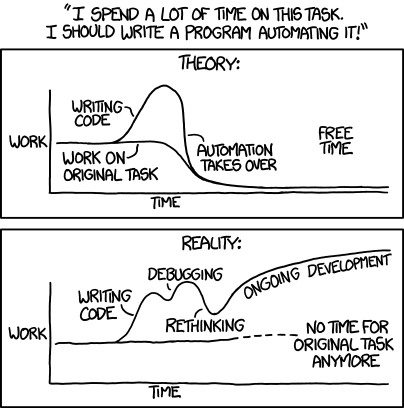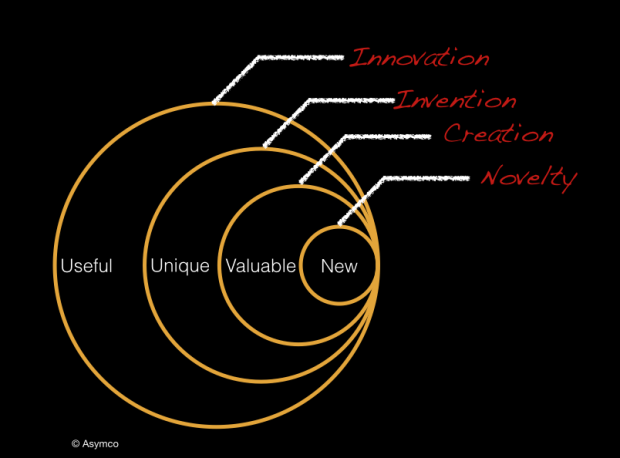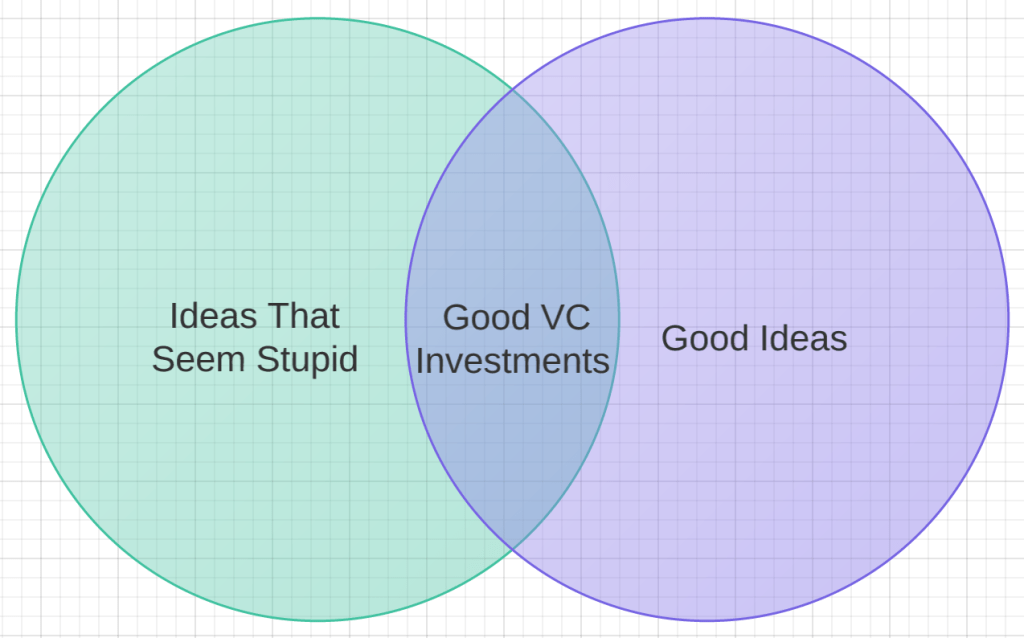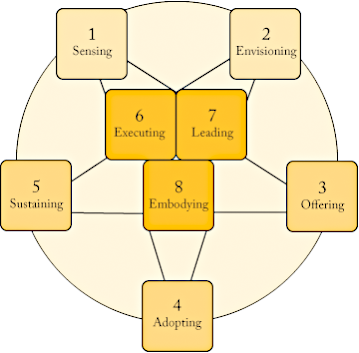Innovation is about finding a better way of doing something. Like many of the new development buzzwords (which many of them are over-used on many business documents), the concept of innovation originates from the world of business. It refers to the generation of new products through the process of creative entrepreneurship, putting it into production, and diffusing it more widely through increased sales. Innovation can be viewed as t he application of better solutions that meet new requirements, in-articulated needs, or existing market needs. This is accomplished through more effective products, processes, services, technologies, or ideas that are readily available to markets, governments and society. The term innovation can be defined as something original and, as a consequence, new, that “breaks into” the market or society.
Innoveracy: Misunderstanding Innovation article points out that there is a form of ignorance which seems to be universal: the inability to understand the concept and role of innovation. The way this is exhibited is in the misuse of the term and the inability to discern the difference between novelty, creation, invention and innovation. The result is a failure to understand the causes of success and failure in business and hence the conditions that lead to economic growth. The definition of innovation is easy to find but it seems to be hard to understand. Here is a simple taxonomy of related activities that put innovation in context:
- Novelty: Something new
- Creation: Something new and valuable
- Invention: Something new, having potential value through utility
- Innovation: Something new and uniquely useful
The taxonomy is illustrated with the following diagram.
The differences are also evident in the mechanisms that exist to protect the works: Novelties are usually not protectable, Creations are protected by copyright or trademark, Inventions can be protected for a limited time through patents (or kept secret) and Innovations can be protected through market competition but are not defensible through legal means.
Innovation is a lot of talked about nowdays as essential to businesses to do. Is innovation essential for development work? article tells that innovation has become central to the way development organisations go about their work. In November 2011, Bill Gates told the G20 that innovation was the key to development. Donors increasingly stress innovation as a key condition for funding, and many civil society organisations emphasise that innovation is central to the work they do.
Some innovation ideas are pretty simple, and some are much more complicated and even sound crazy when heard first. The is place for crazy sounding ideas: venture capitalists are gravely concerned that the tech startups they’re investing in just aren’t crazy enough:
Not all development problems require new solutions, sometimes you just need to use old things in a slightly new way. Development innovations may involve devising technology (such as a nanotech water treatment kit), creating a new approach (such as microfinance), finding a better way of delivering public services (such as one-stop egovernment service centres), identifying ways of working with communities (such as participation), or generating a management technique (such as organisation learning).
Theorists of innovation identify innovation itself as a brief moment of creativity, to be followed by the main routine work of producing and selling the innovation. When it comes to development, things are more complicated. Innovation needs to be viewed as tool, not master. Innovation is a process, not a one time event. Genuine innovation is valuable but rare.
There are many views on the innovation and innvation process. I try to collect together there some views I have found on-line. Hopefully they help you more than confuze. Managing complexity and reducing risk article has this drawing which I think pretty well describes innovation as done in product development:
8 essential practices of successful innovation from The Innovator’s Way shows essential practices in innovation process. Those practices are all integrated into a non-sequential, coherent whole and style in the person of the innovator.
In the IT work there is lots of work where a little thinking can be a source of innovation. Automating IT processes can be a huge time saver or it can fail depending on situation. XKCD comic strip Automation as illustrates this:

System integration is a critical element in project design article has an interesting project cost influence graphic. The recommendation is to involve a system integrator early in project design to help ensure high-quality projects that satisfy project requirements. Of course this article tries to market system integration services, but has also valid points to consider.
Core Contributor Loop (CTTDC) from Art Journal blog posting Blog Is The New Black tries to link inventing an idea to theory of entrepreneurship. It is essential to tune the engine by making improvements in product, marketing, code, design and operations.






5,702 Comments
Tomi Engdahl says:
https://www.sciencealert.com/earth-has-received-a-message-laser-beamed-from-10-million-miles-away
Tomi Engdahl says:
Lucid dream startup says engineers can write code in their sleep. Work may never be the same
Lucid dream startup says engineers can write code in their sleep. Work may never be the same
https://fortune.com/2023/11/30/lucid-dream-startup-prophetic-headset-prepare-meetings-while-sleeping/?fbclid=IwAR1vyErDbv9wPfxMZH0ddyJ_MU2kEWuRnuo5vu7azPc9Pwpb5rEkwn6HXf0
People spend one-third of their lives asleep. What if employees could work during that time … in their dreams?
Prophetic, a venture-backed startup founded earlier this year, wants to help workers do just that. Using a headpiece the company calls the “Halo,” Prophetic says consumers can induce a lucid dream state, which occurs when the person having a dream is aware they are sleeping. The goal is to give people control over their dreams, so they can use that time productively. A CEO could practice for an upcoming board meeting, an athlete could run through plays, a web designer could create new templates—“the limiting factor is your imagination,” founder and CEO Eric Wollberg told Fortune.
Tomi Engdahl says:
Stages of analyzing your task – take some time, don’t be reactive
what are you doing?
what kind of problem in general you try to solve?
where does the problem originate? Is it recurring, or unexpected?
have you streamlined and minimized the amount of work to solve this instance?
can you get better at what you are doing?
how long the whole task takes, in minutes?
what are the steps?
what are exceptional things that happened, if anything?
can you iron out the exceptions (from happening) to streamline your task more?
what is your attitude when starting doing the task?
what were positive unexpected surprises that happened?
can the task affect other things that you will have to do during today?
can you change your attitude?
do you feel physical pain when doing the task?
if the pain is a major issue in avoidance behavior, can you change the pain-causing attributes of the task?
Tomi Engdahl says:
https://etn.fi/index.php/13-news/15597-akut-latautuvat-nopeammin-uudet-nanonauhat-lupaavat-paljon
Tomi Engdahl says:
https://etn.fi/index.php/opinion/15596-hologrammeja-ja-muotoaan-muuttavia-laitteita-tyoenteko-muuttuu-pian
Tomi Engdahl says:
https://reneweconomy.com.au/small-modular-nuclear-reactors-a-history-of-failure/
Tomi Engdahl says:
Microsoft inches closer to glass storage breakthrough that could finally make ransomware attacks impossible in the data center and hyperscalers — but only Azure customers will benefit from it
News
By Keumars Afifi-Sabet published 3 days ago
The technology is strikingly similar to ceramics-based storage and may replace current day technology soon
https://www.techradar.com/pro/microsoft-inches-closer-to-glass-storage-breakthrough-that-could-finally-make-ransomware-attacks-impossible-in-the-data-center-and-hyperscalers-but-only-azure-customers-will-benefit-from-it
Tomi Engdahl says:
24/7 solar towers could double energy output
https://techxplore.com/news/2023-12-solar-towers-energy-output.html
Tomi Engdahl says:
This cyborg cockroach could be the future of earthquake search and rescue
From drivable bionic animals to machines made from muscle, biohybrid robots are on their way to a variety of uses.
https://www.nature.com/articles/d41586-023-03801-0
Tomi Engdahl says:
Kohtaavatko kvanttimekaniikka ja suhteellisuusteoria viimein? Uusi teoria on nyt esitetty, ja ”monet fyysikot eivät pidä” sen ideasta
https://tekniikanmaailma.fi/kohtaavatko-kvanttimekaniikka-ja-suhteellisuusteoria-viimein-uusi-teoria-on-nyt-esitetty-ja-monet-fyysikot-eivat-pida-sen-ideasta/
Tomi Engdahl says:
Japanese Institute breaks optical fiber speed record with 22.9 petabits per second — 1,000 times faster than existing cables
News
By Roshan Ashraf Shaikh published 4 days ago
Speedy thing goes in, speedy thing comes out.
https://www.tomshardware.com/tech-industry/manufacturing/japanese-institute-breaks-optical-fiber-speed-record-with-229-petabits-per-second-1000-times-faster-than-existing-cables
Tomi Engdahl says:
Physicists ‘entangle’ individual molecules for the first time, hastening possibilities for quantum computing
https://phys.org/news/2023-12-physicists-entangle-individual-molecules-hastening.html#google_vignette
Tomi Engdahl says:
Unlocking the secrets of oobleck—strange stuff that’s both liquid and solid
Scientists tested hypothesis with dense suspensions of piezoelectric nanoparticles.
https://arstechnica.com/science/2023/12/unlocking-the-secrets-of-oobleck-strange-stuff-thats-both-liquid-and-solid/
Tomi Engdahl says:
DARPA-Funded Research Leads to Quantum Computing Breakthrough
Harvard-led team develops novel logical qubits to enable scalable quantum computers
https://www.darpa.mil/news-events/2023-12-06
Tomi Engdahl says:
Tähän Playboyn keskiaukeamalta 1973 luvatta revittyyn potrettiin perustuu lähes jokainen digikuva ja video maailmassa – Yksi historian tärkeimmistä valokuvista
Kuvan perusteella optimoitiin jpg- ja mp4-formaatit. 2010-luvun lopulta alkaen se on joutunut epäsuosioon, sillä sitä on alettu pitää naisia väheksyvänä.
https://www.tekniikkatalous.fi/uutiset/tahan-playboyn-keskiaukeamalta-1973-luvatta-revittyyn-potrettiin-perustuu-lahes-jokainen-digikuva-ja-video-maailmassa-yksi-historian-tarkeimmista-valokuvista/0a73f785-4e0e-4d4d-b1ec-6e49e9f03dc4#Echobox=1702791986
Tomi Engdahl says:
New brain-like transistor goes ‘beyond machine learning’
News
By Keumars Afifi-Sabet published 3 days ago
Scientists have previously only gotten ‘synaptic transistors’ to work under cryogenic conditions, but this is the first that can operate at room temperature — while outperforming today’s best-in-class machine learning systems.
https://www.livescience.com/technology/electronics/new-brain-like-transistor-goes-beyond-machine-learning
Tomi Engdahl says:
THE QUANTUM PHANTOM
A ghostly quasiparticle rooted in a century-old Italian mystery could unlock quantum computing’s potential—if only it could be pinned down
https://www.science.org/content/article/ghostly-quasiparticle-rooted-century-old-mystery-unlock-quantum-computings-potential
Tomi Engdahl says:
Researchers create first programmable, logical quantum processor
https://techxplore.com/news/2023-12-programmable-logical-quantum-processor.html#google_vignette
Tomi Engdahl says:
https://ankitkumarmahakur.medium.com/40-famous-quotes-of-socrates-to-be-your-best-version-in-life-d74b3d48e600
Tomi Engdahl says:
What Greece’s Leaders Can Learn From Greek Philosophers
Greece’s prime ministers and cabinet must submit a plan to European creditors.
https://abcnews.go.com/Business/greeces-leaders-learn-greek-philosophers/story?id=32332459#amp_tf=L%C3%A4hde%3A%20%251%24s&aoh=17029013867630&referrer=https%3A%2F%2Fwww.google.com&share=https%3A%2F%2Fabcnews.go.com%2FBusiness%2Fgreeces-leaders-learn-greek-philosophers%2Fstory%3Fid%3D32332459
Tomi Engdahl says:
Scientists discovered ultra-hard material that could rival diamond
The second hardest material after diamond
https://www.techexplorist.com/ultra-hard-material-rival-diamond/78518/
Tomi Engdahl says:
Design tokenit – avain suunnittelijoiden ja kehittäjien tehokkaaseen yhteistyöhön
https://www.fraktio.fi/blogi/design-tokenit-avain-suunnittelijoiden-ja-kehitt%C3%A4jien-tehokkaaseen-yhteisty%C3%B6h%C3%B6n
Tomi Engdahl says:
https://www.facebook.com/100064672212764/posts/pfbid031ifXn8CZky75ZsCHtxzCSSuSALxAuF8ABJK26KZ9CcYxb3BqtjDU1kPp8iFjqPpwl/
Hyperloop One, the futurist transportation company (in case you forgot) that promised to whisk passengers and cargo in vacuum-sealed tubes at jet speeds from city to city, is officially over – but this time, it’s for real. According to Bloomberg, the much-hyped, long-beleaguered company will officially close its doors on December 31….
The pipe dream is over: Hyperloop One shuts down
https://electrek.co/2023/12/22/the-pipe-dream-is-over-hyperloop-one-calls-it-quits/?fbclid=IwAR3WCCh5imO5jPArekBscMH8kfZTBEPwo-nrvoxVRFYk2WcAfRNle7wBHCw
Hyperloop One, the futurist transportation company (in case you forgot) that promised to whisk passengers and cargo in vacuum-sealed tubes at jet speeds from city to city, is officially over – but this time, it’s for real. According to Bloomberg, the much-hyped, long-beleaguered company will officially close its doors on December 31.
Elon Musk put forth his original idea in an “alpha paper” back in 2013, which theorized that aerodynamic pods filled with passengers or cargo could be whisked, Jetsons-style, through tubes at up to 760 mph to and from cities. He described it as a “fifth mode of transportation,” with a dream scenario being Los Angeles to San Francisco and New York to DC in 30 minutes, ultimately transforming our lives and work.
While scientists and engineers debunked the project as grossly improbable, no matter, Musk’s idea proved too irresistible. In 2014, Hyperloop One raised, and subsequently burned through, hundreds of millions of dollars in developing its vision, which went through multiple iterations over the years. Virgin Group’s billionaire Richard Branson brought his financial heft to the company in 2017, bringing in $350 million in investments alongside Dubai-based port logistics firm DP World, but that money got quickly spent.
There were other bumps in the road as well
Tomi Engdahl says:
Magnetic Knots Push Future Computing Toward 3D Twisted structures called hopfions are easy to move but hard to destroy
https://spectrum.ieee.org/topology-in-computer-magnetic-knots?share_id=8014319&socialux=facebook&utm_campaign=RebelMouse&utm_content=IEEE+Spectrum&utm_medium=social&utm_source=facebook&fbclid=IwAR3qfszXqBEfeMJNJMkOC_4XevsmUmqJNe-fcCb1wfQ9z0ueCR6hq9DHyMQ
Tomi Engdahl says:
Yhdet vielä? Mitä todella tapahtuu, kun alkoholia mikroannostellaan
TUTKIJALTAMitä tapahtuisi, jos yrittäisi mikroannostella alkoholia tehokkaasti työaikana suorituskyvyn parantamiseksi, kysyy professori Harry Sumnall Liverpoolin John Moores -yliopistosta.
https://tekniikanmaailma.fi/yhdet-viela-mita-todella-tapahtuu-kun-alkoholia-mikroannostellaan/#Echobox=1702439360
Tanskalaisen ohjaajan Thomas Vinterbergin uusimmassa elokuvassa Yhdet vielä ystävät Martin, Tommy, Peter ja Nikolaj tekevät pienen kokeen: he ovat pienessä humalassa koko päivän nähdäkseen, miten se vaikuttaa heidän sosiaaliseen ja ammatilliseen suoritukseensa.
Neljä keski-ikäistä miestä ovat tyytymättömiä opettajien työhönsä kööpenhaminalaisessa lukiossa. Nikolajin 40-vuotissyntymäpäivänä keskustellaan norjalaispsykiatrista Finn Skårderudista, joka väittää, että ihmisillä on luonnollinen alkoholinpuute ja että 0,5 promillen alkoholipitoisuus veressä tekee ihmisestä luovemman ja rennomman.
Tomi Engdahl says:
Laboratoriotutkimukset ovat osoittaneet, että alhaisilla annoksilla alkoholin tuottama rentoutumisen ja itseluottamuksen tunteen lisääntyminen sekä lievän päihtymyksen aiheuttama kognitiivisen keskittymisen menetys voivat johtaa luovempiin ja monipuolisempiin ongelmanratkaisustrategioihin, parantuneeseen vieraan kielen taitoon, terävämpään muistiin ja parantaa kykyä käsitellä tietyntyyppisiä tietoja. Sitä vastoin analyyttiset ongelmanratkaisutaidot, joita tarvitaan useimmilla työpaikoilla, kärsivät kaikilla kulutuksen tasoilla.
Tomi Engdahl says:
Joulupukin historia: Viikinkien jumalista paksuun amerikkalaispukkiin
Joka vuosi punanuttuinen sankari suoriutuu valtavasta lahjojenjakourakasta ilahduttaakseen lapsia. Valkoparran takana piileskelee historiallinen henkilö, 1 700 vuotta sitten elänyt kreikkalaispiispa.
https://historianet.fi/joulu/joulupukin-historia-viikinkien-jumalista-paksuun-amerikkalaispukkiin
Tomi Engdahl says:
U.S. Govt and researchers seemingly discover new type of superconductivity in an exotic, crystal-like material — controllable variation breaks temperature records
News
By Francisco Pires published 6 days ago
Increasing resolution into the moment where matter changes states.
https://www.tomshardware.com/tech-industry/superconductors/us-govt-and-researchers-seemingly-discover-new-type-of-superconductivity-in-an-exotic-crystal-like-material-controllable-variation-breaks-temperature-records
Tomi Engdahl says:
https://arstechnica.com/science/2022/09/celibacy-its-surprising-evolutionary-advantages-according-to-new-research/
Tomi Engdahl says:
https://www.sciencealert.com/scientists-built-a-functional-computer-with-human-brain-tissue
Tomi Engdahl says:
https://www.livescience.com/technology/engineering/scientists-uncover-the-secret-to-building-star-wars-style-laser-weapons-but-dont-worry-we-wont-have-a-death-star-anytime-soon
Tomi Engdahl says:
https://spectrum.ieee.org/photonic-chip?share_id=8022584&socialux=facebook&utm_campaign=RebelMouse&utm_content=IEEE+Spectrum&utm_medium=social&utm_source=facebook&fbclid=IwAR1e7tG871eX7wByt9C0O2SpzblKWYHvn2NUt01HGTX5IPOOKsSA4ncyz_A
Tomi Engdahl says:
https://www.sciencealert.com/quantum-batteries-could-provide-a-new-kind-of-energy-storage-by-messing-with-time
Tomi Engdahl says:
In a study published in the journal PNAS, researchers from Linköping University have developed an electrically conductive “soil” which can boost the plant growth by 50% in 15 days. https://ie.social/e8OK1
Tomi Engdahl says:
We need a moonshot for computing
The US government aims to push microelectronics research forward. But maintaining competitiveness in the long term will require embracing uncertainty.
https://www.technologyreview.com/2023/12/28/1084686/computing-microelectronics-chips-act/
Tomi Engdahl says:
https://www.iflscience.com/having-a-higher-iq-puts-you-more-at-risk-of-mental-illness-study-finds-44223
Tomi Engdahl says:
Onko kaikki sittenkin vain simulaatiota? Uusi tutkimus tukee hypoteesia simuloidusta universumista
5.1.202407:51
Uusi tutkimus tarjoaa tieteellistä näyttöä hypoteesille simuloidusta universumista.
https://www.mikrobitti.fi/uutiset/onko-kaikki-sittenkin-vain-simulaatiota-uusi-tutkimus-tukee-hypoteesia-simuloidusta-universumista/838574ad-246b-4301-8f8d-1fa1ceaabfc1
Elämmekö oikeassa maailmassa vai onko kaikki vain suuri simulaatio?
Uusi fysiikan laki voisi osoittaa maailmankaikkeuden olevan simulaatio, uutisoi Vice.
Vopsonin tutkimus on julkaistu American Institute of Physics (AIP) Publishing -lehdessä.
Tutkimus osoittaa, että olemassa olevat tietojärjestelmät käyvät läpi jonkinlaisen minimointiprosessin ajan myötä. Tämä on samanlaista kuin tiedon pakkaaminen ja optimointi tietokoneissa, mikä viittaa siihen, että maailma olisi vain suuri simulaatio.
Mind-Blowing New Law of Physics Could Mean We Really Live in a Simulation, Physicist Proposes
“Being a simulation is a possible consequence (or conclusion)” of the proposed second law of infodynamics, physicist Melvin Vopson says.
https://www.vice.com/en/article/5d9k8a/new-law-of-physics-could-mean-we-really-live-in-a-simulation-physicist-proposes
Are we living in a simulation? It’s a trippy idea that has inspired many classic tales, from Plato’s Allegory of the Cave to The Matrix franchise, but it is also increasingly becoming a subject of genuine scientific debate and inquiry.
The second law of infodynamics and its implications for the simulated universe hypothesis
https://pubs.aip.org/aip/adv/article/13/10/105308/2915332/The-second-law-of-infodynamics-and-its
The simulation hypothesis is a philosophical theory, in which the entire universe and our objective reality are just simulated constructs. Despite the lack of evidence, this idea is gaining traction in scientific circles as well as in the entertainment industry. Recent scientific developments in the field of information physics, such as the publication of the mass-energy-information equivalence principle, appear to support this possibility. In particular, the 2022 discovery of the second law of information dynamics (infodynamics) facilitates new and interesting research tools at the intersection between physics and information. In this article, we re-examine the second law of infodynamics and its applicability to digital information, genetic information, atomic physics, mathematical symmetries, and cosmology, and we provide scientific evidence that appears to underpin the simulated universe hypothesis.
Tomi Engdahl says:
New Transistors Might Need a Different Cut of Silicon Devices might do better on a different crystal plane
https://spectrum.ieee.org/silicon-crystal
Tomi Engdahl says:
https://thedebrief.org/darpa-research-makes-a-groundbreaking-discovery-in-quantum-computing-developing-the-worlds-first-logical-qubit-circuit/
Tomi Engdahl says:
https://hackaday.com/2023/12/31/how-ibm-stumbled-onto-risc/
Tomi says:
https://www.msn.com/fi-fi/uutiset/other/keksinn%C3%B6t-jotka-koituivat-kuolemaksi-niiden-keksij%C3%B6ille/ss-AA1n0G5s?ocid=entnewsntp&pc=HCTS&cvid=fa4ea33698a44b51b194af35ed437bc8&ei=27#image=1
Tomi says:
https://etn.fi/index.php/13-news/15735-puhelin-voisi-kestaeae-viikon-lataamatta-litiummetalliakulla
Tomi Engdahl says:
Akku, jota ei tarvitse ladata 50 vuoteen – kiinalaiset väittävät sen olevan valmis ja soveltuvan myös sähköautoon
https://www.is.fi/autot/art-2000010121418.html
Tomi says:
https://etn.fi/index.php/13-news/15744-grafeeni-voi-mullistaa-mikropiirit-mutta-nopeaa-apua-siitae-ei-tule
Tomi Engdahl says:
https://www.helsinki.fi/fi/uutiset/ihmisten-teknologia/neutronitahtien-kvarkkiaineytimien-kohtalo-selviamassa?fbclid=IwAR3z5SfMRSgnJQi7ny86yZQB2xmqVqEFuMSjEo1xzh26whrHWlEFthE-7KE
Tomi Engdahl says:
Karel Čapek loathed the idea of using the term “robot” to refer to electromechanical machines, but accepted that the world had different ideas.
The Man Who Coined The Word “Robot” Defends Himself Karel Čapek explains what everyone has been getting wrong about his creation
https://spectrum.ieee.org/karel-capek-robots?share_id=8051814&socialux=facebook&utm_campaign=RebelMouse&utm_content=IEEE+Spectrum&utm_medium=social&utm_source=facebook&fbclid=IwAR0WS0WABG9XbdWRd6-24jcMDohYBMCIrQX-ddGl6jz4-LaaJ1YEhnQSYgY
You’re familiar with Karel Čapek, right? If not, you should be—he’s the guy who (along with his brother Josef) invented the word “robot.” Čapek introduced robots to the world in 1921, when his play “R.U.R.” (subtitled “Rossum’s Universal Robots”) was first performed in Prague. It was performed in New York City the next year, and by the year after that, it had been translated into 30 languages. Translated, that is, except for the word “robot” itself, which originally described artificial humans but within a decade of its introduction came to mean things that were mechanical and electronic in nature.
Čapek, it turns out, was a little miffed that his “robots” had been so hijacked, and in 1935, he wrote a column in the Lidové noviny “defending” his vision of what robots should be, while also resigning himself to what they had become. A new translation of this column is included as an afterword in a new English translation of R.U.R. that is accompanied by 20 essays exploring robotics, philosophy, politics, and AI in the context of the play, and it makes for fascinating reading.
Tomi Engdahl7 says:
Dr. Dave Mills created NTP, the protocol that holds the temporal Internet together, 1985 and died at age 85. #RIP
Tomi Engdahl7 says:
Inventor of NTP protocol that keeps time on billions of devices dies at age 85
Dave Mills created NTP, the protocol that holds the temporal Internet together, in 1985.
https://arstechnica.com/gadgets/2024/01/inventor-of-ntp-protocol-that-keeps-time-on-billions-of-devices-dies-at-age-85/?fbclid=IwAR2DxI2FmhL1bOg5fOxILcWfcpqW0Wwgin4ZYAsmwU_vcnKkhxWjXCBFyEU
Tomi Engdahl says:
https://www.tomshardware.com/pc-components/cpus/coal-could-be-in-your-next-cpu-researchers-eye-coal-as-a-metal-oxide-insulator-replacement-in-next-gen-2d-transistors
Tomi Engdahl says:
Helppo ja edullinen tapa suojata muistia – uusi tutkimus antoi lisätietoa
https://www.is.fi/terveys/art-2000010154066.html